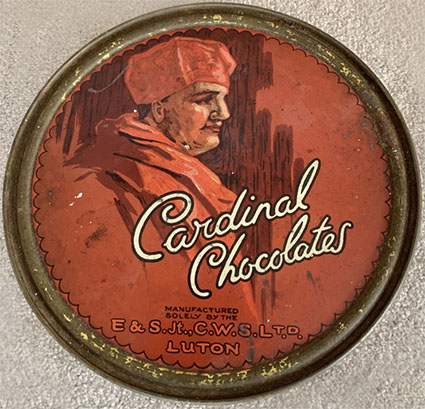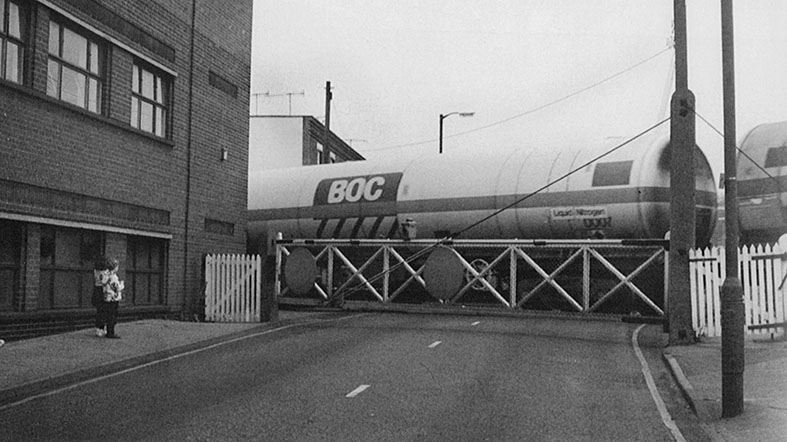- Screen Colours:
- Normal
- Black & Yellow
 Cardinal Chocolates from Sylvia Patsalides
Cardinal Chocolates from Sylvia Patsalides
I read the article about the Silburys, lockdown and Cardinal Wolsey [Issue 225] and attach a photograph of my Wolsey Chocolates tin produced by E & S CWS Ltd of Luton. I believe that the factory in Luton used to do all the chocolate-related stuff, but will admit to have so far done little research. What chocolates were contained within I wonder?
[Historical note: E&S Joint CWS was the Co-op's 'English & Scottish Tea Society’. As well as packaging tea they also made chocolate (in Luton): the ’Lutona’ brand. -J.N.]
Ipswich Dock Tramway from Stephen Poole
I’m glad I listened to Stuart Grimwade’s talk to the Ipswich Society on 28 April 2021. In case it’s of interest to any members of the Society, here are some comments regarding the last use of the dock tramway – along with some of the wider issues that affected it. I’m basing my comments on recollections from my time as a Development Manager for one of BR Railfreight’s sectors in the late 1980s.
I recall that the Lower Yard was used at various times for stone trains and container traffic as well as for the BOC industrial gases tanks from Ditton (near Runcorn). Stuart showed us a picture of the BOC tanks crossing Ranelagh Road Level Crossing. These flows, from Railfreight’s perspective, were ‘trainload’, i.e. they ran as full trains from origin to destination under contract for a single customer. The container trains would at that time have been run under contract to Freightliner, which was a separate entity. The sector I worked for, however, ran most of its traffic as ‘wagonload’ and this meant scratching around to get traffic to make up trains that could sometimes be as little as one wagon and at other times mean leaving wagons behind because there were too many. Therefore it was hard to allocate or underwrite resources – or to provide a consistent level of service. Malt and grain were two of many examples where we had dearths of traffic and then gluts and these were the two remaining traffics to and from the docks at Ipswich, where we ran them for R&W Paul. These were the only flows to go further than the Lower Yard, and so our sector had to foot the bill for maintenance and renewal of the infrastructure across the Stoke Bridge road. We also had to pay the full costs of the pilot engine needed to move the wagons to and from Paul’s. Despite these costs, there was no regular contract for any of this sporadic traffic and, as accounting practices sharpened up, it became increasingly apparent that wagonload was not paying its way. This was important when you bear in mind that public subsidy for Railfreight had been stopped by the outgoing Labour government in 1979. The miners’ strike in the 1980s then cost Railfreight about £300m, none of which could be recovered other than from within its own resources. So loss-making services were increasingly coming under very harsh scrutiny. Looking back, it’s a miracle wagonload survived for as long as it did.

Photograph from J.Freestone/R.Smith: ‘Ipswich Engines and Ipswich Men’
We made huge amounts of effort, however. Our sector had three sales reps in south-east England and I recall the one for East Anglia (Paul Philips) making frequent trips to the grain and malt traders in order to drum up traffic for rail. I know he went to R&W Paul’s on a regular basis. Similarly, I visited places (although not Ipswich as far as I can recall) to develop new flows and try to make savings on the operation of existing traffic. We actively marketed grain movements by rail under the brand name Grainflow. As late as 1987 we were investing money in a new fleet of two-axle rail vans, such as we saw with Railfreight branding at R&W Paul’s silo in one of the photos Stuart showed us. But the plug was pulled and Railfreight went over almost entirely to trainload. Consequently very many sidings and freight-only lines were closed and the traffic went by road instead. The private sector freight companies which took over after privatisation were not interested in wagonload traffic and they still aren’t.
As I say, I’m basing this on recollections rather than research, but anybody interested in the wider issues I’ve hinted at can ‘read all about it’ in my book Inside British Rail, The History Press 2018, ISBN 9 780750 985567 90100.
Stephen Poole